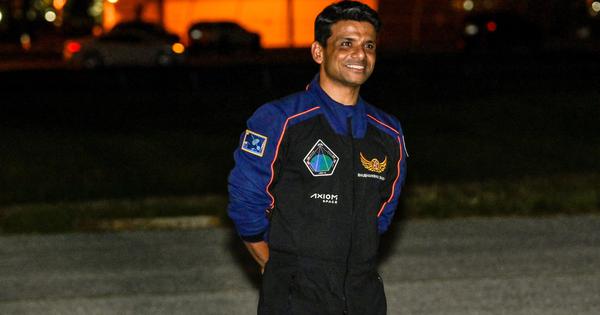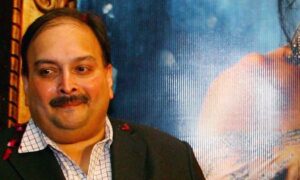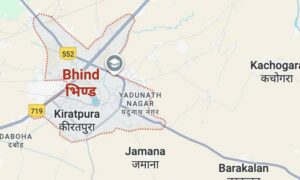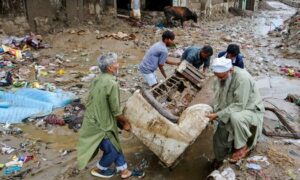
The humming air filters and softly blinking control panels of the International Space Station’s laboratory module formed the backdrop to Group Captain Shubhanshu Shukla’s daily routine in orbit. Over 18 days aboard the ISS, Shukla and his Axiom-4 crewmates immersed themselves in science – conducting over 60 experiments spanning medicine, agriculture, and space technology. At the heart of Shukla’s mission were seven pioneering microgravity experiments from India, a suite of investigations that marked India’s first science programme on the ISS. Each morning, as Earth rotated silently below, Shukla floated into the lab, ready to become not just an astronaut but also a researcher, farmer and explorer of living systems in space. The station’s cramped corridors had transformed into a makeshift cosmic laboratory, where sprouting seeds, glowing microbes, tiny “water bears”, and human cells all became part of a grand scientific narrative.
Shukla gently pushed off a handrail, gliding toward the Life Sciences Glovebox in Japan’s Kibo module. The bright illumination inside the sealed workspace cast a glow on his focused face as he prepared an experiment. Peggy Whitson, the veteran commander, floated nearby and gave an encouraging nod. “All set, Shux?” she asked softly. Shukla smiled and recalled countless training sessions on Earth where he had practised these very motions in simulated weightlessness. Now, in microgravity, even simple tasks like transferring a drop of liquid or swiping a touchscreen demanded new adaptations. Yet here he was – steady hands, steady heart – ready to unlock scientific insights on behalf of Indian scientists watching from 400 km below. As he began the day’s work, he felt the weight of expectation not as a burden, but as wind beneath his wings, propelling him through each procedure. This chapter chronicles Shukla’s journey through those experiments – blending technical precision with human moments of wonder, challenge and inspiration.
Inside the glovebox, Shukla’s gloved hands hovered around a biocell culture plate containing delicate human muscle stem cells. “Myogenesis”, the experiment was called – a study of muscle cell regeneration in microgravity. Its goal was ambitious – to understand and combat the muscle atrophy that plagues astronauts on long missions, while offering clues for treating muscle-wasting diseases on Earth. Floating next to him was a pouch labelled “Metabolic Supplements”. These contained natural flavonoid compounds, which he would add to some cell samples to test if they could boost muscle repair in weightlessness.
Shukla’s movements were methodical. First, he retrieved a tiny syringe filled with differentiation media, a nourishing solution. With utmost care, he injected the media into the wells of the BioCell plate – an action he would repeat every two days for eight days to stimulate the muscle stem cells to develop into fibre-like muscle tissue. As he injected the fluid, the droplet initially formed a perfect sphere in mid-air before he guided it into contact with the cell culture. He chuckled inwardly at how microgravity turned pipetting into a dance with liquid orbs, recalling scientist Prachi Nawkarkar’s advice that “simple tasks such as pipetting liquids require more practice and patience in microgravity.” Each drop delivered felt like a small victory.
Next came the supplements – a few drops of the flavonoid mixture added to designated wells. This was the core of the Myogenesis investigation – seeing whether these compounds could support mitochondrial function and enhance muscle regeneration. As he worked, Shukla narrated his steps for the camera recording the experiment, knowing that scientists like Dr Arvind Ramanathan of InStem Bengaluru were observing keenly from mission control. Ramanathan’s team had a ground control culture running in parallel on Earth. The plan was to compare how the space-grown muscle cells fared versus Earth’s gravity-bound ones once the samples returned home.
Shukla’s mind wandered to a flashback – the lab at IISc (Indian Institute of Science) where he trained during his MTech. He remembered long hours learning to handle biological samples with precision, peering at cells through microscopes. That training was now his compass. “Microgravity adds complexity, but the principles are the same,” he had told a reporter before the mission. In the glovebox, those words rang true. He felt a surge of appreciation for the scientific mentors and protocols that prepared him for this moment.
After securing the samples, Shukla took a moment to gaze at the cells through a magnifier. Tiny clusters of human muscle precursor cells were adhering to their scaffolds, looking innocuous yet holding secrets to major questions. What makes muscles weaken so dramatically in space? Can we block that process? The preliminary answers would come from analysis of these microcultures. As he carefully sealed the plate and slid it into the station’s incubator, Peggy’s voice came through: “Nice work. Those cells are in good hands.” Shukla grinned.
He floated back, stretching his own arms and legs in mid-air – a physical reminder of the muscles he was trying to protect. Astronauts can lose up to 20 per cent of their muscle mass on long flights, and understanding the cellular causes is crucial. NASA’s notes on Myogenesis highlighted that microgravity likely disrupts mitochondria, the powerhouses of cells, impairing muscle repair. By testing metabolic supplements on muscle stem cells, Shukla’s work could lead to interventions that maintain muscle health during long missions. The implications excited him; he imagined a future crew on a voyage to Mars, their bodies strong thanks to discoveries made in these very plates. He also thought of patients on Earth – perhaps someday an elderly person gaining mobility because of a treatment that stemmed from this experiment.
“One particular research I am really excited about is the stem cell research,” Shukla had shared during an in-orbit science briefing. “We’re trying to see if we can accelerate recovery or repair injury by adding supplements to stem cells. It’s been great working in the glovebox on this,” he had told Axiom’s chief scientist with visible enthusiasm. His voice carried the passion of a test pilot-turned-scientist eager to push frontiers. Now, in the quiet after the intense focus, Shukla felt that excitement resonate within. He cleaned up the glovebox, tucking away tools, and allowed himself a satisfied breath. The Myogenesis experiment was proceeding as planned, and he was a step closer to unravelling the mysteries of muscle loss in space – and perhaps on Earth.
Before moving on to the next task, Shukla recorded a short video log. “Day 8,” he spoke into the camera, the Indian flag patch on his shoulder visible, “our muscle cells are growing well. The supplements have been added. The team on the ground will analyse if these helped boost regeneration. It’s amazing – microgravity here mimics muscle ageing or disease on Earth, just faster. We’re looking for what blocks muscle repair in space and whether our added nutrients can help unblock it. Fingers crossed for some promising data.” His tone was hopeful. In his mind’s eye, he could see the scientists back home – some of India’s top biologists – nodding in agreement.
As he switched off the camera, Shukla felt a profound connection between the ISS lab and the labs across India that had nurtured these experiments. This was science without borders, stretching from Bengaluru to Earth orbit. Unhooking his feet from the workstation, he gently propelled himself toward the next experiment setup, ready to become a space farmer next.
Excerpted with permission from Sky Was Never the Limit: The Story of Shubhanshu Shukla, Narayan R, Rupa Publications.
📰 Crime Today News is proudly sponsored by DRYFRUIT & CO – A Brand by eFabby Global LLC
Design & Developed by Yes Mom Hosting






